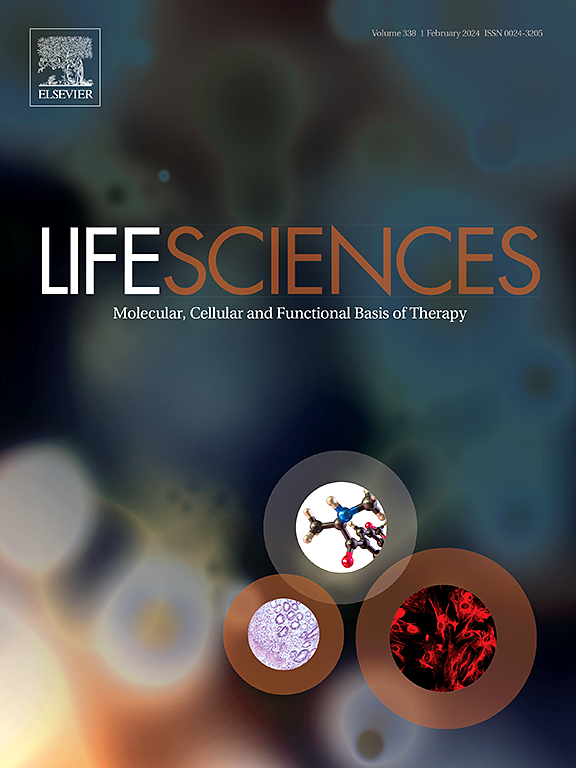罗格列酮诱导的白色脂肪细胞褐变受肌动蛋白和 Myh9 的调控。
IF 5.1
2区 医学
Q1 MEDICINE, RESEARCH & EXPERIMENTAL
引用次数: 0
摘要
目的:本研究探讨了罗格列酮诱导白色脂肪细胞棕色化过程中肌动蛋白聚合和Myh9在介导脂滴分裂中的作用。目的是了解脂滴分裂如何有助于白色脂肪组织的米色转化,从而深入了解脂肪细胞的可塑性和代谢调节:将 C3H10 T1/2 分化脂肪细胞作为研究白色脂肪细胞褐变的经典模型。使用罗格列酮诱导褐变,并使用免疫荧光和 Western 印迹法评估 LDs 与肌动蛋白之间的相互作用以及 Myh9 的分布。在体内,我们使用微丝抑制剂阻断冷刺激小鼠的肌动蛋白聚合,并评估了LD形态和褐变的变化。此外,我们还使用共聚焦显微镜进行了动态活细胞成像,以观察褐变过程中 LD 的实时行为,并确定它们是否发生裂变:我们的研究结果表明,罗格列酮能显著诱导LD体积缩小,这一过程与LD与微丝的接触增加有关。抑制肌动蛋白的聚合可阻止LD体积的缩小和白色脂肪细胞的褐变,这表明肌动蛋白起着关键作用。Myh9富集于LD裂变点,形成了类似收缩环的结构。过量表达Myh9可促进LD收缩,表明它可能参与了LD裂变:这项研究确定了肌动蛋白和Myh9是罗格列酮诱导白色脂肪细胞褐变过程中LD裂变的关键调控因子,为脂肪细胞可塑性的细胞机制提供了新的见解。研究结果提出了一种新的途径,通过这种途径,LD动态促进了白色脂肪的米色转化,这对针对脂肪细胞功能和能量消耗的代谢疾病疗法具有潜在的意义。本文章由计算机程序翻译,如有差异,请以英文原文为准。
Rosiglitazone-induced white adipocyte browning is regulated by actin and Myh9
Aims
This study investigates the role of actin polymerization and Myh9 in mediating lipid droplet (LD) fission during rosiglitazone-induced browning of white adipocytes. The aim is to understand how LD splitting might contribute to the beige conversion of white adipose tissue, providing insights into adipocyte plasticity and metabolic regulation.
Materials and methods
C3H10 T1/2-differentiated adipocytes were used as a classical model to study white adipocyte browning. Rosiglitazone was applied to induce browning, and the interactions between LDs and actin, as well as the distribution of Myh9, were assessed using immunofluorescence and Western blotting. In vivo, we employed a microfilament inhibitor to block actin polymerization in cold-stimulated mice and evaluated changes in LD morphology and browning. Furthermore, dynamic live-cell imaging using confocal microscopy was conducted to observe the real-time behavior of LDs during the browning process and to determine whether they undergo fission.
Main findings
Our results demonstrate that rosiglitazone significantly induces LD size reduction, a process correlated with the increased contact of LDs with microfilaments. Inhibition of actin polymerization prevented both the reduction in LD size and the browning of white adipocytes, indicating that actin plays a critical role. Myh9 was enriched at the LD fission sites, forming a structure resembling a contractile ring. Overexpression of Myh9 promoted the shrinkage of LD, suggesting that it may be involved in LD fission.
Significance
This study identifies actin and Myh9 as key regulators of LD fission in rosiglitazone-induced browning of white adipocytes, offering new insights into the cellular mechanisms of adipocyte plasticity. The findings propose a novel pathway by which LD dynamics contribute to the beige conversion of white fat, with potential implications for metabolic disease therapies targeting adipocyte function and energy expenditure.
求助全文
通过发布文献求助,成功后即可免费获取论文全文。
去求助
来源期刊

Life sciences
医学-药学
CiteScore
12.20
自引率
1.60%
发文量
841
审稿时长
6 months
期刊介绍:
Life Sciences is an international journal publishing articles that emphasize the molecular, cellular, and functional basis of therapy. The journal emphasizes the understanding of mechanism that is relevant to all aspects of human disease and translation to patients. All articles are rigorously reviewed.
The Journal favors publication of full-length papers where modern scientific technologies are used to explain molecular, cellular and physiological mechanisms. Articles that merely report observations are rarely accepted. Recommendations from the Declaration of Helsinki or NIH guidelines for care and use of laboratory animals must be adhered to. Articles should be written at a level accessible to readers who are non-specialists in the topic of the article themselves, but who are interested in the research. The Journal welcomes reviews on topics of wide interest to investigators in the life sciences. We particularly encourage submission of brief, focused reviews containing high-quality artwork and require the use of mechanistic summary diagrams.
 求助内容:
求助内容: 应助结果提醒方式:
应助结果提醒方式:


